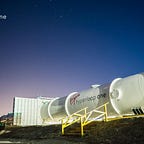We Just Made A Strong Move Ahead In Autonomous Mobility
The Hyperloop will be a range extender for vehicle clouds — handling intercity transport for the likes of Uber, Didi, and Tesla.
By Bruce Upbin, Hyperloop One
Yesterday and 500 meters high in the Burj Khalifa tower, Hyperloop One signed an agreement with Dubai’s Roads and Transport Authority (RTA) to explore high-speed routes in the United Arab Emirates. The RTA runs all the public transport (road, metro, maritime) in Dubai and connects with the infrastructure of greater UAE and the Gulf region beyond. The headlines talked up the wonders of getting from Dubai to Abu Dhabi in 12 minutes, but the real story here is how an original and new wrinkle in the autonomous mobility landscape is coming into focus.
This feasibility study with the RTA is our second agreement in the UAE, following our deal to explore a cargo system with DP World in August, and it’s our sixth route study overall. We’re going to spend the next 12 weeks working with design and architecture firm BIG, transportation consultants at McKinsey & Co., and the RTA to figure out where and how to build what would likely be a hybrid passenger-freight system in Emirates. We proved our ability to work fast at the Dubai Future Accelerators, where the RTA was our partner. With this next step they become our customer and will sponsor this study. “Dubai makes perfect sense for Hyperloop One because this is the 21st century’s global transport hub and its leaders understand that Hyperloop One is ushering in the next era of transportation,” says Shervin Pishevar, Executive Chairman, Hyperloop One.
Today we also get to answer a question we receive often: What will it be like to ride the Hyperloop? The images coming out today show how much better travel can be as an experience if you break it down to first principles. Our engineering, product and business teams worked with the thinkers at BIG over the last six months and came up with an original system design that solves the challenge of loading lots of passengers quickly into a Hyperoop tube while creating whole new opportunities to deliver a better passenger experience.
The set of products we’re showing include Hyperportals (the equivalent of stations or airports) and autonomous Hyperpods that dock into our transporters for long-distance travel but can also move around town on their own. Our infrastructure doesn’t have to work with our pods alone. We can turn it into a platform that works with self-driving Teslas, BMWs, or any of the urban mini-cars on the horizon. And we’ll partner with companies like Uber and Didi to build networks in cities everywhere. Hyperloop One will be the range extender for the connected urban vehicle cloud. You can imagine all kinds of data and services we can deliver off that platform. It’s a huge new product direction for us and we’re going to be filling in the details as we head toward the public Kitty Hawk demonstration next year.
The video below shows the concept in action, but the idea is that you would launch our app on your phone and, with a tap, an autonomous Hyperpod appears and drives you into the portal and docks inside a waiting transporter and off you go directly to the destination portal where your pod emerges from the transporter and heads off to your final stop. Your doors only open twice. Every journey is direct. Everything operates on your schedule. “We’re going to create a seamless experience that starts the moment you think about being somewhere — not going somewhere,” says Josh Giegel, President of Engineering, Hyperloop One. “We don’t sell cars, boats, trains, or planes. We sell time.”
Hyperpods can seat anywhere from six to 100 people as comfortably as a living room. Companies can have their own custom meeting pods. So can families — think of it as a long-distance minivan. There could even be a critical-care pod to whisk patients to the hospital. And, yes, with a translucent or transparent-walled pod, we can even do windows. One of the ideas the designers at BIG came up with was to install narrow slits on the tube at regular intervals to create a zoetrope effect that tricks the eye into seeing as a moving image of the outside world.
The Hyperpod concept unlocks a bigger vision for what Hyperloop One can be as a company. No other transportation infrastructure can combine the freedom of individual travel with the efficiency of collective travel. Giegel said it best earlier today when he declared that “today we become more than just a pod-in-a-tube company” or “the fast train from San Francisco to Los Angeles” and plant stakes in the bigger arena of autonomous mobility.
Read more about our progress at Hyperloop One’s Medium:
